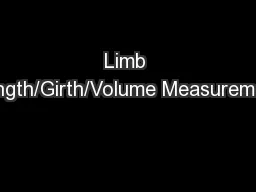

PHT 1261C Tests and Measurements Dr Kane Definition anthropometry What is it Why is it important Anthropometric Measurements What do we measure Edema Localized swelling Joint effusion ID: 295563
Download Presentation The PPT/PDF document "Limb Length/Girth/Volume Measurement" is the property of its rightful owner. Permission is granted to download and print the materials on this web site for personal, non-commercial use only, and to display it on your personal computer provided you do not modify the materials and that you retain all copyright notices contained in the materials. By downloading content from our website, you accept the terms of this agreement.
Slide1
Limb Length/Girth/Volume Measurement
PHT 1261C Tests and Measurements
Dr. KaneSlide2
Definition – anthropometry
What is it?
Why is it important?
Anthropometric MeasurementsSlide3
What do we measure?Slide4
EdemaLocalized swelling
Joint effusion
Muscular changesAsymmetry of body partsEffects of surgical procedures
What to measure?Slide5
Aids clinician in determining pt.'s impairments to provide the appropriate treatmentProvides baseline data information to monitor progress and outcomes
Provides feedback & motivation for patients
Aids in designing equipment and materials for special populationsProvides info in design of objects and spaces used by normal population
Why measure?Slide6
Tape MeasureSteel Tape
Volumeter
AnthropometerCalipersPerometry – infrared laser
Bioimpedence
What to measure with?Slide7
Measurement ToolsSlide8
Using the Tape Measure
Measure in cm
Place the tape measure flat on the body The tape measure should be stretched out and not slack
If the segment to be measured is irregular or conical in shape, the proximal part of the tape should be flat
When measuring circumference, surround the body part without undue constricting pressureSlide9
IndicationsUpper Extremity
Arm
ForearmLower ExtremityThigh/FemurLeg
Limb Length MeasurementSlide10
Indications Upper Extremity
Arm
ForearmLower ExtremityThighLeg
Other areas
Hands, feet, waist, hips, head
Girth MeasurementsSlide11
IndicationsTrue (anatomical) vs. Apparent (functional)
A difference of 1.0 to 1.5 cm is still considered normal but may be symptomatic
Valid & ReliableSources of error – muscle bulk, clothing, palpation
Leg Length MeasurementSlide12
True Leg LengthASIS
Medial Malleolus
Lateral MalleolusSpecific location of differenceASIS to greater trochanter – hip valgus/
varus
Greater trochanter to lateral joint line – femur
Medial joint line of knee to medial malleolus – tibiaInterpreting results
Leg Length MeasurementSlide13
Apparent Leg LengthIndications
Landmarks:
UmbilicusMedial MalleolusInterpretation
Leg Length MeasurementSlide14
True vs. Apparent Leg LengthSlide15
Common True LLD Etiologies
Common etiologies of true leg length discrepancies:
Idiopathic developmental abnormality
Fracture
Trauma to epiphyseal plate
Legg-Calve Perthes Disease
Malignancies
Infections
Slide16
Common etiologies of apparent leg length discrepancies
:
Soft tissue shortening
Joint contractures
Ligamentous laxity
Foot mechanics
LBP
ScoliosisSlide17
Indirect Method of Measuring Leg
Length
-
done through palpation of bony
landmarks such as the ASIS or the iliac
crest- use of blocks of given thickness